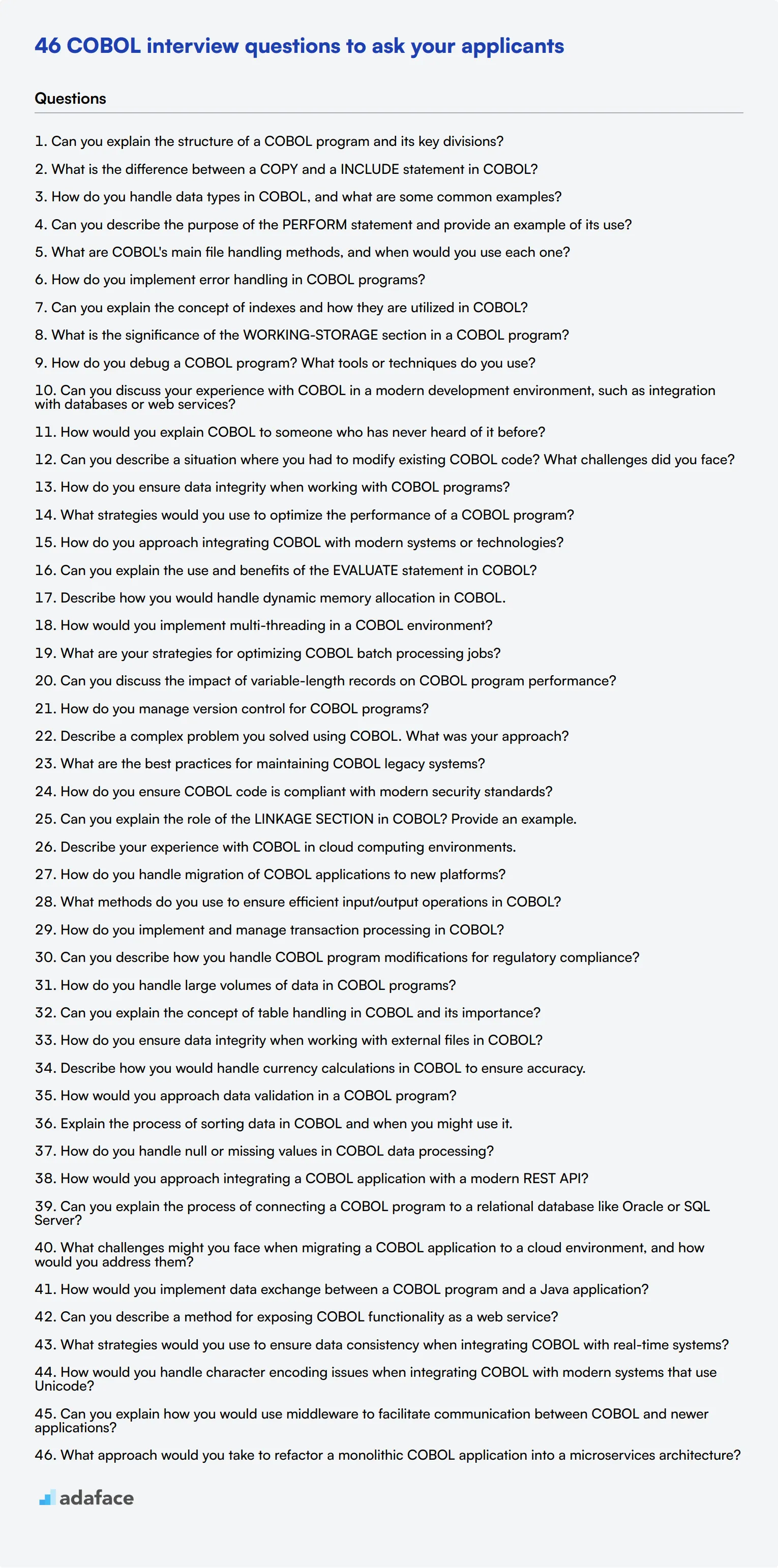Hiring the right COBOL developer is crucial for maintaining and improving legacy systems. Knowing the right interview questions can help you evaluate technical skills and problem-solving abilities effectively.
This blog post covers 10 common COBOL interview questions, questions for junior and senior developers, data handling, and legacy systems integration. It's a comprehensive guide to assist recruiters and hiring managers in making informed decisions.
By using this guide, you can streamline your interview process and identify top talent. For a more efficient hiring process, consider using COBOL online test before the interviews.
Table of contents
10 common COBOL interview questions to ask your applicants

To gauge the technical expertise of your COBOL applicants, consider using these interview questions. They will help you assess not only their knowledge of COBOL but also their problem-solving skills in real-world scenarios. For more insights on finding the right candidates, check out our mainframe developer job description.
- Can you explain the structure of a COBOL program and its key divisions?
- What is the difference between a COPY and a INCLUDE statement in COBOL?
- How do you handle data types in COBOL, and what are some common examples?
- Can you describe the purpose of the PERFORM statement and provide an example of its use?
- What are COBOL's main file handling methods, and when would you use each one?
- How do you implement error handling in COBOL programs?
- Can you explain the concept of indexes and how they are utilized in COBOL?
- What is the significance of the WORKING-STORAGE section in a COBOL program?
- How do you debug a COBOL program? What tools or techniques do you use?
- Can you discuss your experience with COBOL in a modern development environment, such as integration with databases or web services?
5 COBOL interview questions and answers to evaluate junior developers
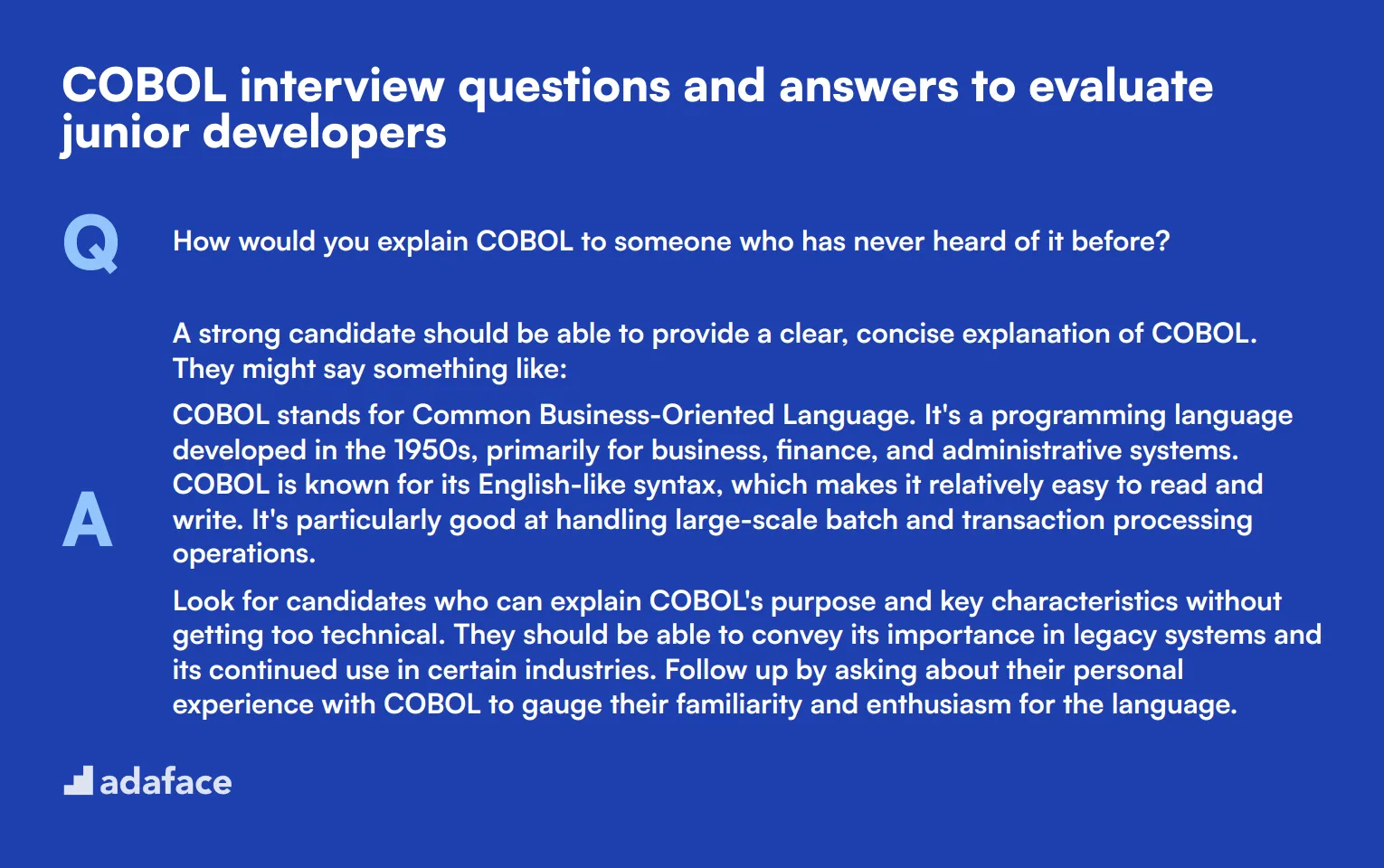
Ready to put your junior COBOL developer candidates through their paces? This curated list of interview questions will help you evaluate their foundational knowledge and problem-solving skills. Use these questions to assess their understanding of COBOL basics and their ability to apply concepts in real-world scenarios. Remember, the goal is to find that diamond in the rough who can grow into a COBOL superstar!
1. How would you explain COBOL to someone who has never heard of it before?
A strong candidate should be able to provide a clear, concise explanation of COBOL. They might say something like:
COBOL stands for Common Business-Oriented Language. It's a programming language developed in the 1950s, primarily for business, finance, and administrative systems. COBOL is known for its English-like syntax, which makes it relatively easy to read and write. It's particularly good at handling large-scale batch and transaction processing operations.
Look for candidates who can explain COBOL's purpose and key characteristics without getting too technical. They should be able to convey its importance in legacy systems and its continued use in certain industries. Follow up by asking about their personal experience with COBOL to gauge their familiarity and enthusiasm for the language.
2. Can you describe a situation where you had to modify existing COBOL code? What challenges did you face?
This question helps assess a candidate's practical experience with COBOL. A good answer might include:
- Description of a specific project or task
- Explanation of the changes required
- Challenges encountered, such as understanding legacy code or maintaining compatibility
- Steps taken to overcome these challenges
- Outcome of the modifications
Look for candidates who demonstrate problem-solving skills, attention to detail, and an understanding of the importance of maintaining existing systems. Their answer should reflect an ability to work with legacy code and adapt to different coding styles. Consider asking follow-up questions about their approach to documentation or testing after making changes.
3. How do you ensure data integrity when working with COBOL programs?
Data integrity is crucial in COBOL programming, especially in financial and business applications. A strong candidate should mention several strategies:
- Using appropriate data types and field sizes to prevent data truncation or overflow
- Implementing input validation to ensure data meets expected formats and ranges
- Utilizing file status checks to confirm successful file operations
- Employing error handling routines to manage unexpected situations
- Implementing transaction processing techniques for critical operations
- Regular testing and debugging to catch potential issues
Pay attention to candidates who emphasize the importance of thorough testing and validation in maintaining data integrity. They should demonstrate an understanding of COBOL's strengths in handling large volumes of data and the responsibility that comes with it. Consider asking about specific examples from their experience to gauge their practical knowledge.
4. What strategies would you use to optimize the performance of a COBOL program?
An experienced COBOL developer should be familiar with various optimization techniques. A good answer might include:
- Minimizing I/O operations by using efficient file handling techniques
- Optimizing loops and conditional statements
- Using appropriate data types and structures
- Employing table handling techniques for faster data access
- Utilizing in-line PERFORM statements where appropriate
- Considering the use of indexed files for quicker data retrieval
- Analyzing and optimizing SQL statements in COBOL-DB2 programs
Look for candidates who not only list these techniques but can also explain when and why they would apply them. They should demonstrate an understanding of the balance between code readability and performance. You might want to follow up with questions about specific optimization challenges they've faced in real projects.
5. How do you approach integrating COBOL with modern systems or technologies?
This question assesses a candidate's ability to bridge the gap between legacy COBOL systems and modern technologies. A strong answer might include:
- Utilizing middleware or APIs to facilitate communication between COBOL and other systems
- Implementing web services to expose COBOL functionality
- Using COBOL-Java interoperability features
- Employing tools that allow COBOL programs to interact with databases like Oracle or SQL Server
- Considering containerization for COBOL applications to improve portability and scalability
Look for candidates who demonstrate knowledge of both COBOL and modern integration techniques. They should show an understanding of the challenges involved in integrating legacy systems and the importance of maintaining system integrity during the process. Consider asking about specific integration projects they've worked on to gauge their practical experience.
15 advanced COBOL interview questions to ask senior developers
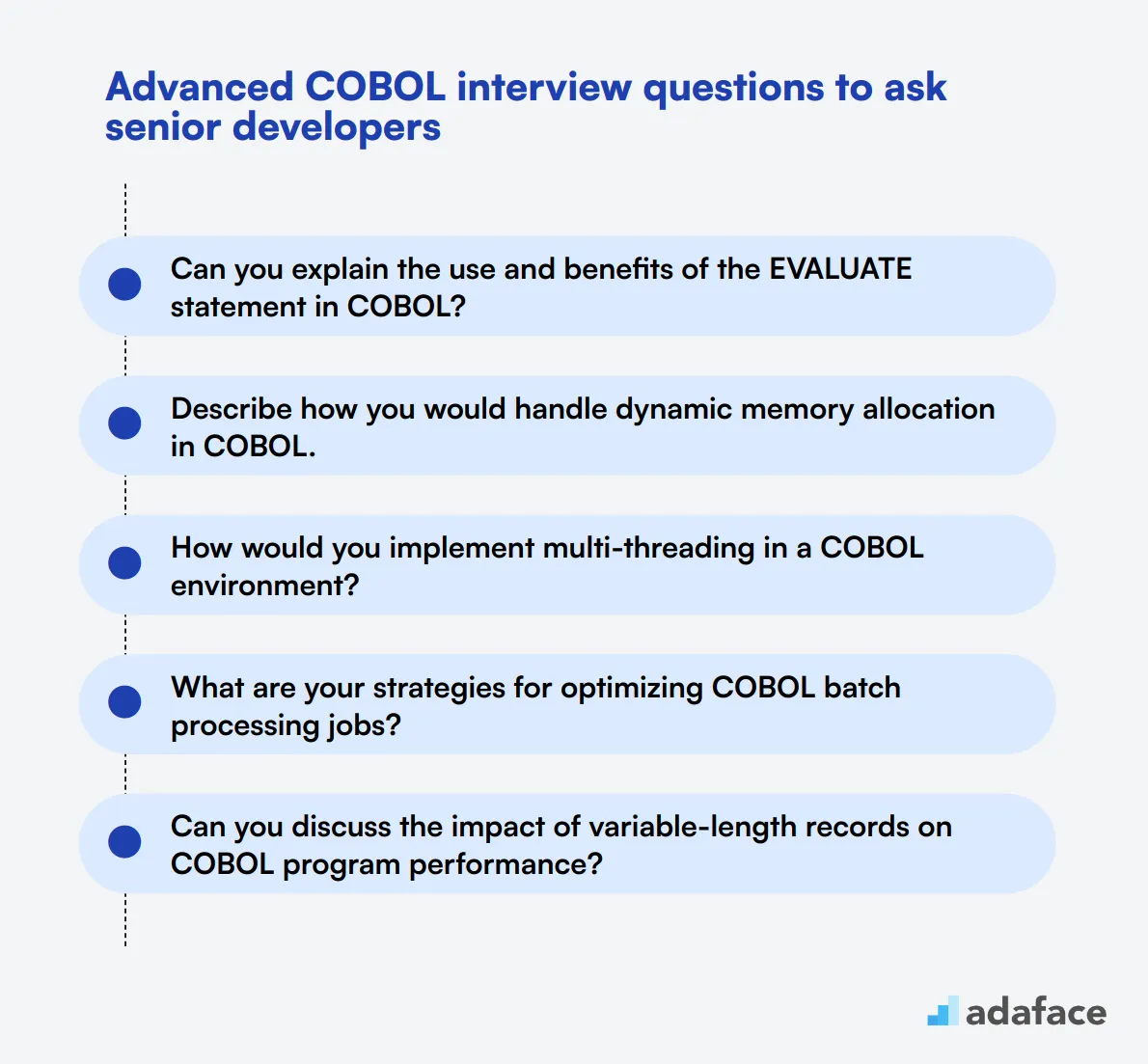
To assess whether candidates possess advanced COBOL skills essential for senior roles, consider using these targeted interview questions. These questions will help you gauge their expertise and problem-solving abilities, ensuring they are well-equipped to handle complex tasks. For more details on what skills to look for, refer to our mainframe developer guide.
- Can you explain the use and benefits of the EVALUATE statement in COBOL?
- Describe how you would handle dynamic memory allocation in COBOL.
- How would you implement multi-threading in a COBOL environment?
- What are your strategies for optimizing COBOL batch processing jobs?
- Can you discuss the impact of variable-length records on COBOL program performance?
- How do you manage version control for COBOL programs?
- Describe a complex problem you solved using COBOL. What was your approach?
- What are the best practices for maintaining COBOL legacy systems?
- How do you ensure COBOL code is compliant with modern security standards?
- Can you explain the role of the LINKAGE SECTION in COBOL? Provide an example.
- Describe your experience with COBOL in cloud computing environments.
- How do you handle migration of COBOL applications to new platforms?
- What methods do you use to ensure efficient input/output operations in COBOL?
- How do you implement and manage transaction processing in COBOL?
- Can you describe how you handle COBOL program modifications for regulatory compliance?
7 COBOL interview questions and answers related to data handling
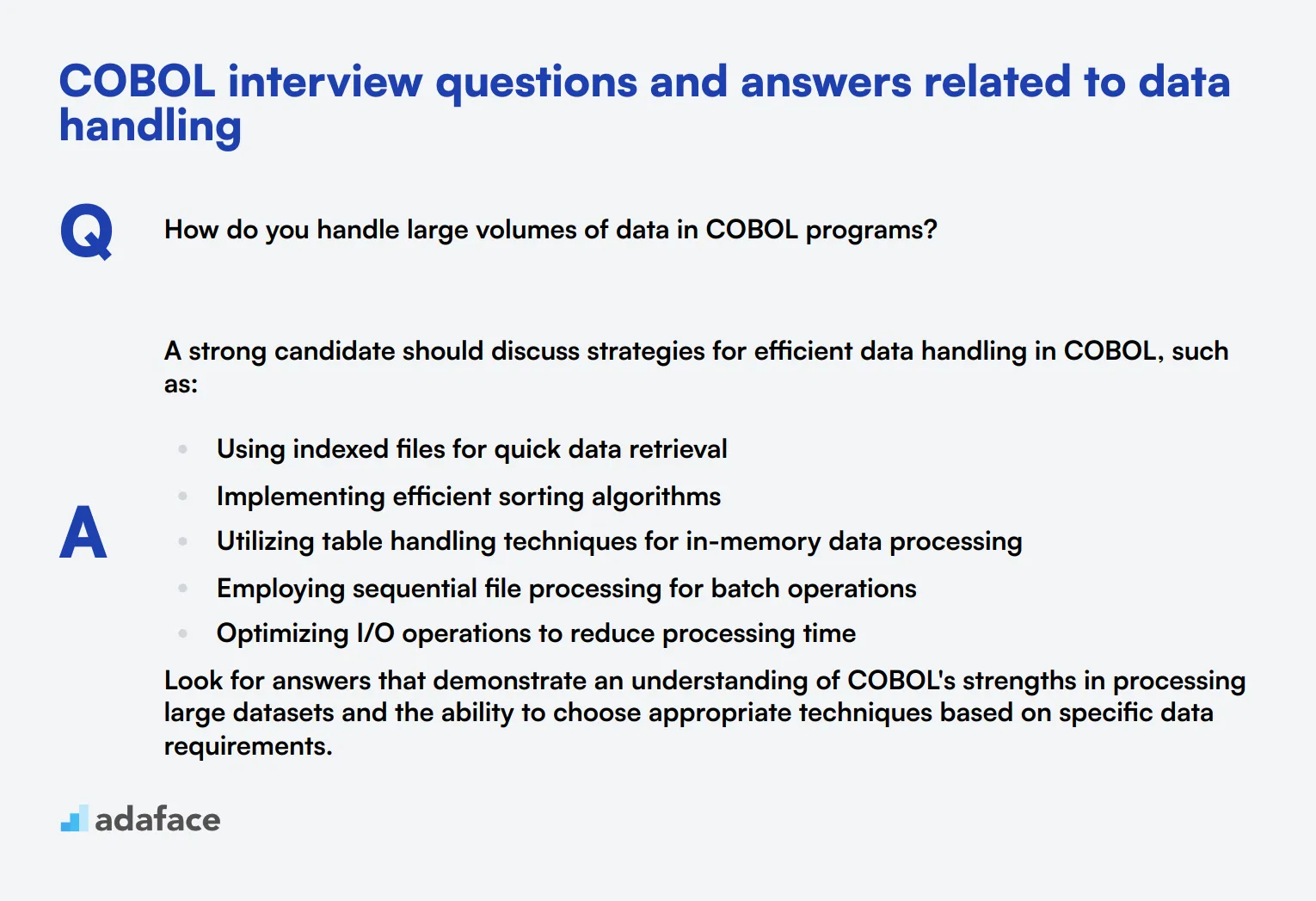
When interviewing for COBOL positions, it's crucial to assess candidates' data handling skills. These questions will help you gauge applicants' proficiency in managing and manipulating data within COBOL programs. Use them to identify skilled developers who can effectively work with COBOL's unique data structures and file systems.
1. How do you handle large volumes of data in COBOL programs?
A strong candidate should discuss strategies for efficient data handling in COBOL, such as:
- Using indexed files for quick data retrieval
- Implementing efficient sorting algorithms
- Utilizing table handling techniques for in-memory data processing
- Employing sequential file processing for batch operations
- Optimizing I/O operations to reduce processing time
Look for answers that demonstrate an understanding of COBOL's strengths in processing large datasets and the ability to choose appropriate techniques based on specific data requirements.
2. Can you explain the concept of table handling in COBOL and its importance?
Table handling in COBOL refers to the manipulation of arrays or multi-dimensional data structures. It's crucial for efficient data processing and storage. Candidates should explain that tables in COBOL allow for:
- Storing multiple related data items under a single name
- Easily accessing and manipulating grouped data
- Improving code readability and maintainability
- Enhancing performance when working with large datasets
Evaluate responses based on the candidate's ability to articulate the benefits of table handling and provide examples of how they've used it in real-world scenarios.
3. How do you ensure data integrity when working with external files in COBOL?
Ensuring data integrity is crucial when working with external files. A competent COBOL developer should mention several strategies:
- Implementing proper file status checking after each I/O operation
- Using appropriate file organization (sequential, indexed, or relative) based on data access patterns
- Employing record locking mechanisms for multi-user environments
- Implementing transaction processing techniques for critical operations
- Regular data validation and error handling routines
Look for answers that demonstrate a thorough understanding of COBOL's file handling capabilities and a proactive approach to maintaining data integrity throughout file operations.
4. Describe how you would handle currency calculations in COBOL to ensure accuracy.
Handling currency calculations accurately is critical in many COBOL applications, especially in financial systems. A strong candidate should mention:
- Using COMP-3 (packed decimal) or COMP (binary) for internal calculations to maintain precision
- Employing the PICTURE clause with 'V' for implied decimal points
- Utilizing the ROUNDED phrase for rounding operations
- Implementing currency-specific editing symbols for formatting output
- Careful consideration of intermediate results to avoid truncation or overflow
Assess the candidate's awareness of the importance of precision in financial calculations and their familiarity with COBOL's features for handling monetary values accurately.
5. How would you approach data validation in a COBOL program?
Data validation is essential for maintaining data quality and integrity. A proficient COBOL developer should describe a multi-faceted approach:
- Using the PICTURE clause to enforce data types and lengths
- Implementing range checks for numeric fields
- Employing conditional statements (IF, EVALUATE) for complex validation rules
- Utilizing lookup tables or external files for validating against predefined values
- Implementing error handling routines to manage and report validation failures
Look for answers that demonstrate a systematic approach to data validation, covering both simple and complex scenarios, and an understanding of how validation fits into the overall data processing workflow.
6. Explain the process of sorting data in COBOL and when you might use it.
Sorting is a fundamental operation in many COBOL programs. A knowledgeable candidate should explain the process and its applications:
- Using the SORT verb to rearrange records based on specified key fields
- Defining sort keys with ascending or descending order
- Employing INPUT PROCEDURE and OUTPUT PROCEDURE for pre- and post-sort processing
- Utilizing the MERGE verb for combining pre-sorted files
Evaluate responses based on the candidate's understanding of when and how to use sorting effectively, such as for report generation, data analysis, or preparing data for further processing. Look for examples of real-world applications they've encountered.
7. How do you handle null or missing values in COBOL data processing?
Handling null or missing values is crucial for maintaining data integrity and preventing processing errors. A competent COBOL developer should discuss strategies such as:
- Using special values (e.g., high-values, low-values, or specific codes) to represent null
- Implementing conditional logic to check for and handle null values
- Employing the REDEFINES clause to allow for optional fields
- Utilizing level-88 condition names for clear null value checks
- Considering the impact of null values on calculations and comparisons
Look for answers that demonstrate an understanding of the challenges posed by null values in COBOL, which doesn't have a built-in null concept, and the ability to implement robust solutions to handle them effectively.
9 COBOL questions related to legacy systems integration
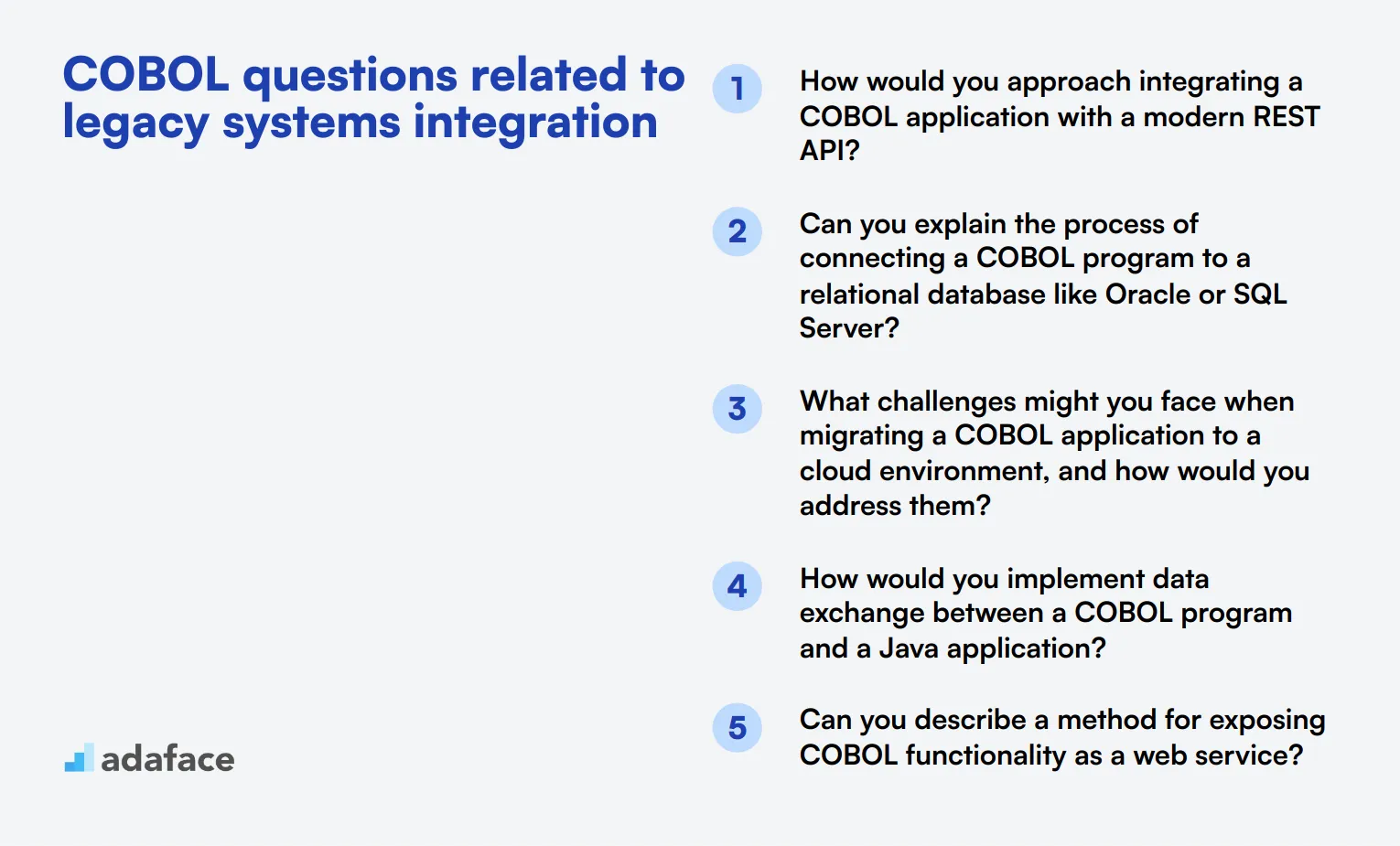
When interviewing for COBOL positions related to legacy systems integration, it's crucial to assess the candidate's ability to bridge old and new technologies. These questions will help you evaluate a mainframe developer's skills in modernizing and integrating COBOL systems with current platforms.
- How would you approach integrating a COBOL application with a modern REST API?
- Can you explain the process of connecting a COBOL program to a relational database like Oracle or SQL Server?
- What challenges might you face when migrating a COBOL application to a cloud environment, and how would you address them?
- How would you implement data exchange between a COBOL program and a Java application?
- Can you describe a method for exposing COBOL functionality as a web service?
- What strategies would you use to ensure data consistency when integrating COBOL with real-time systems?
- How would you handle character encoding issues when integrating COBOL with modern systems that use Unicode?
- Can you explain how you would use middleware to facilitate communication between COBOL and newer applications?
- What approach would you take to refactor a monolithic COBOL application into a microservices architecture?
Which COBOL skills should you evaluate during the interview phase?
While no interview can comprehensively assess every aspect of a candidate's abilities, focusing on core COBOL skills is essential for making informed hiring decisions. Here are the key skills you should evaluate during the interview phase to ensure your candidates have the required expertise.
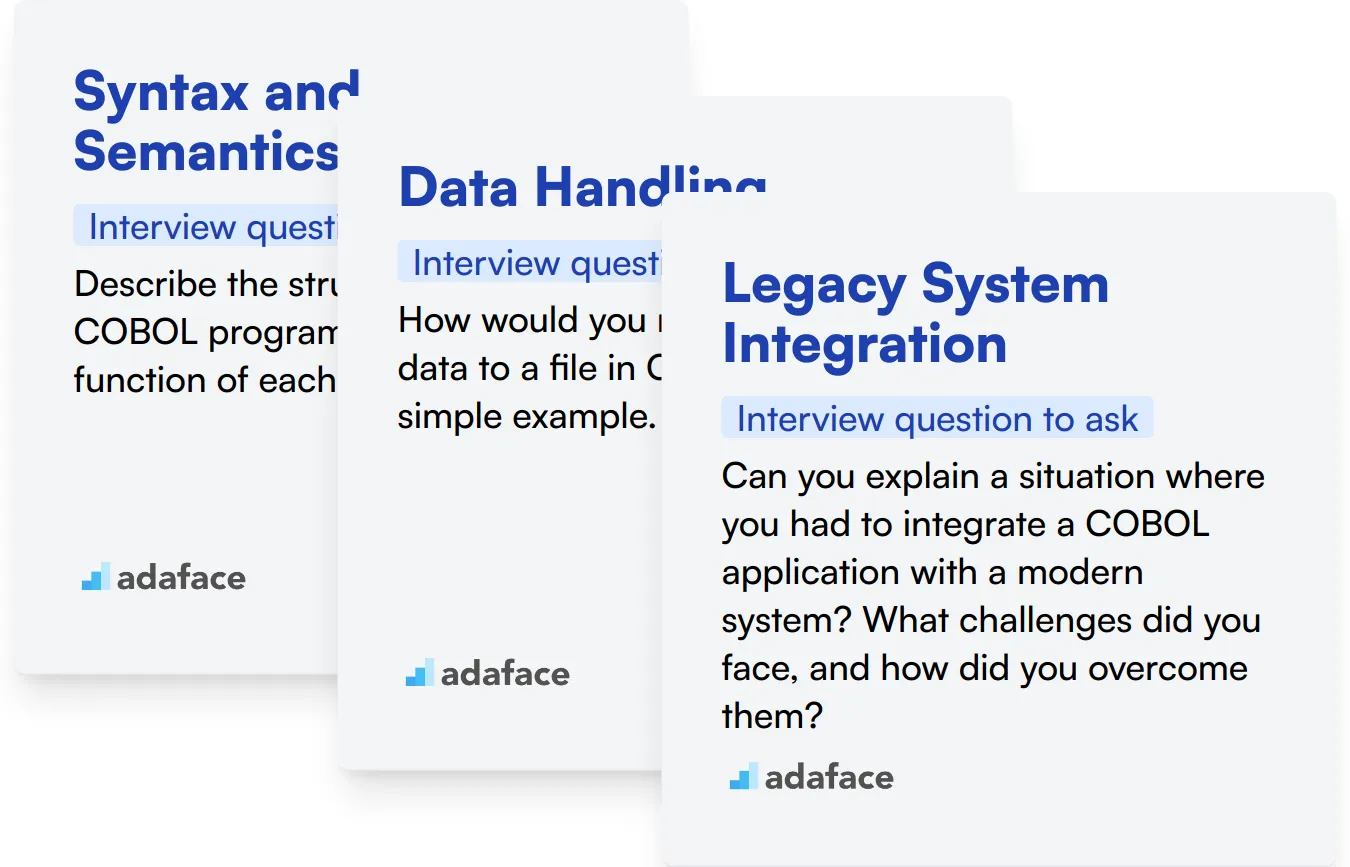
Syntax and Semantics
Mastery of COBOL's syntax and semantics is fundamental to writing and understanding COBOL programs. Candidates need to be well-versed in COBOL's unique structure and commands to maintain and develop efficient programs.
You can use an assessment test that asks relevant MCQs to filter out this skill. Consider using the COBOL Online Test to assess syntax and semantics understanding.
Additionally, during the interview, asking targeted questions can help you evaluate this skill more deeply.
Describe the structure of a COBOL program and explain the function of each division.
Look for answers that accurately describe the Identification, Environment, Data, and Procedure divisions, with detailed explanations of their roles. Candidates should demonstrate a clear understanding of the hierarchical structure of a COBOL program.
Data Handling
COBOL is often used for business applications that handle large volumes of data. Proficiency in data handling ensures developers can effectively manage file operations and database interactions.
Consider using an assessment test to evaluate skills related to data handling. Relevant MCQs in the COBOL Online Test can help filter candidates with strong data handling abilities.
During the interview, you can ask specific questions to understand their proficiency in data handling.
How would you read and write data to a file in COBOL? Provide a simple example.
Expect candidates to describe the file control entries and the READ and WRITE operations. They should provide a clear, concise example demonstrating their practical knowledge of file handling in COBOL.
Legacy System Integration
Legacy system integration is crucial for maintaining and extending the functionality of existing systems. Candidates should demonstrate experience and understanding of integrating COBOL programs with modern technologies and databases.
To assess this skill, consider asking targeted interview questions about their experience with legacy system integration.
Can you explain a situation where you had to integrate a COBOL application with a modern system? What challenges did you face, and how did you overcome them?
Answers should include specific examples of integration projects, the technologies involved, and how they resolved issues. Look for candidates who highlight their problem-solving skills and adaptability in integrating COBOL with newer systems.
Streamline Your COBOL Hiring Process with Skills Tests and Targeted Interviews
When hiring for COBOL positions, it's important to verify candidates' skills accurately. This ensures you find the right fit for your team and projects.
A practical way to assess COBOL proficiency is through skills tests. Consider using our COBOL online test or Mainframe online test to evaluate candidates' abilities.
After candidates complete the skills test, you can shortlist the top performers for interviews. This two-step process helps you focus on the most promising applicants.
Ready to improve your COBOL hiring process? Sign up to access our test library and start assessing candidates today. For more information on our assessment platform, visit our online assessment platform page.
COBOL Online Test
Download COBOL interview questions template in multiple formats
COBOL Interview Questions FAQs
Include a mix of basic concepts, data handling, legacy system integration, and advanced topics to assess candidates at various skill levels.
Focus on fundamental concepts, syntax, and basic problem-solving abilities using entry-level COBOL interview questions.
Explore complex data structures, performance optimization, integration with modern systems, and best practices for maintaining legacy code.
Ask about their experience migrating or integrating COBOL systems with newer technologies and handling compatibility issues.
Yes, consider including short coding tasks or code review exercises to assess hands-on COBOL skills and problem-solving abilities.

40 min skill tests.
No trick questions.
Accurate shortlisting.
We make it easy for you to find the best candidates in your pipeline with a 40 min skills test.
Try for freeRelated posts
Free resources




